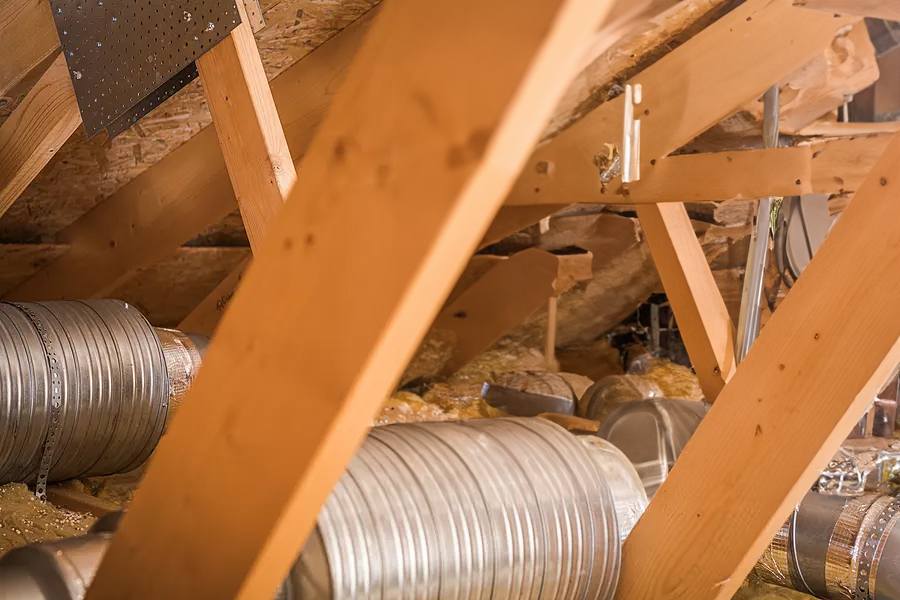If you live in Florida, you probably know it can get fairly humid. However, as the temperature rises and you can feel the moisture in the air, most people don’t consider how it can harm your roof.
Proper attic ventilation acts as a roof moisture barrier in all types of roofing systems all year long. This means you have cooler attics in the summer and drier attics in the winter, preventing material and structural damage.
Undoubtedly, attics are one of the most prevalent places for mold to grow in our homes. But why is this happening, and how can we prevent it? It’s important to understand how your attic ventilation system functions to avoid mold problems in the future.
Why Does Your Home Need Attic Ventilation?
Moisture and heat can deteriorate the roof system and interior structural parts over time and destroy the attic insulation. Mold and mildew can thrive in a warm attic, putting additional strain on the home’s cooling equipment.
When done correctly, ventilation doesn’t harm your home’s climate control. It will, in reality, make it much easier for your attic to avoid moisture.
In an unfinished attic, efficient ventilation includes low intake vents and high exhaust vents along the roof ridge. This permits air to circulate continuously through the room. Cooler external air enters via the soffit vents, and humid, warm air that rises to the highest point departs through the roof ridge vents.
So, proper ventilation in your attic can improve the lifespan of your roof system, future home maintenance expenses, and so much more. That’s why you must prevent molding in your attic.
But –
How Can You Prevent Molding or Mildew in Your Attic Ventilation System?
Due to the high interior humidity, your roof ventilation may not remove enough moisture, allowing mold to form and spread throughout the attic.
Since proper roof ventilation is critical to minimize mold infestations, inspecting your attic for symptoms of humidity and inadequate ventilation is always a good idea. If there’s too much moisture on roofing nails in the attic, it will condense on the upper half of your roof deck, rusting the exposed nail, rotting the deck, and potentially inspiring mold growth.
An infrared roof moisture scan will locate the regions of your roof where moisture is prevalent, allowing you to pinpoint where you should be looking.
You can install a dehumidifier in your attic as a temporary fix, but expect to empty it several times daily until you can hire a professional to come out and look. Apart from that, there are multiple other ways to keep your attic ventilation moisture-free. Let’s take a look at them:
- Reduce or Eliminate Air Leakage
Check and seal any vents leaking warm air into your attic. Inspect the vents for cracks, damaged caulking, and other flaws. These are potential entry locations for humid air leaking into the attic.
- Improve Attic Insulation and Ventilation
Poor ventilation in the attic prevents humid air from escaping once it enters. Inspect all attic ventilation to confirm that it’s operational. Vents may be covered up during repairs or when the attic is insulated. Ensure that all vents are open and no insulation is blocking the vents.
- Ensure Bathroom and Dryer Vents Are Directed Outside.
If your house was not built to code, the bathroom and dryer vents might be venting into your attic rather than outside. Examine your vents to ensure they’re pointing in the appropriate direction, and redirect them if necessary.
- Check If You Have The Right Type of Ventilation
Finally, always study the manufacturer’s instructions for particular installation requirements and guidelines and building science recommendations to confirm the type and amount of ventilation required for your home’s architecture and environment.
A qualified roofer can help properly install and comply with local building codes. That way, you can ensure you have the correct ventilation system for your needs.
Mold and mildew growth will eventually result from moisture, which is both unsightly and detrimental to your health and the health of your property. This can also be disastrous since it may go unrecognized until you notice something off with the structural integrity. Keep an eye out for water damage indicators in your home and get frequent roofing inspections to detect problems early.
If you suspect a problem with humidity in your home and your attic ventilation, please contact Jack C. Wilson Roofing Co. immediately for a professional inspection. We have been a trusted, high-quality roof repair company in North East Florida since 1946. Our team of experts can get your ventilation system up and running quickly.


